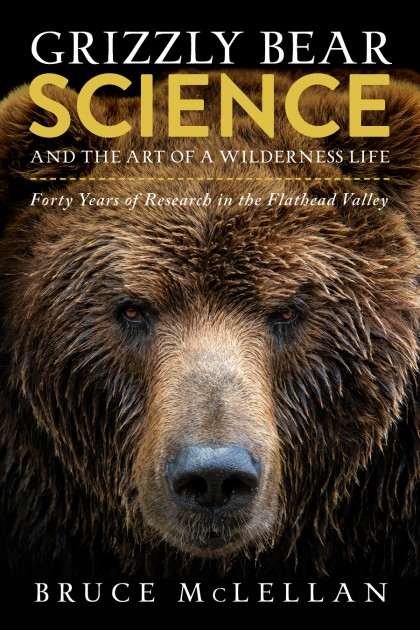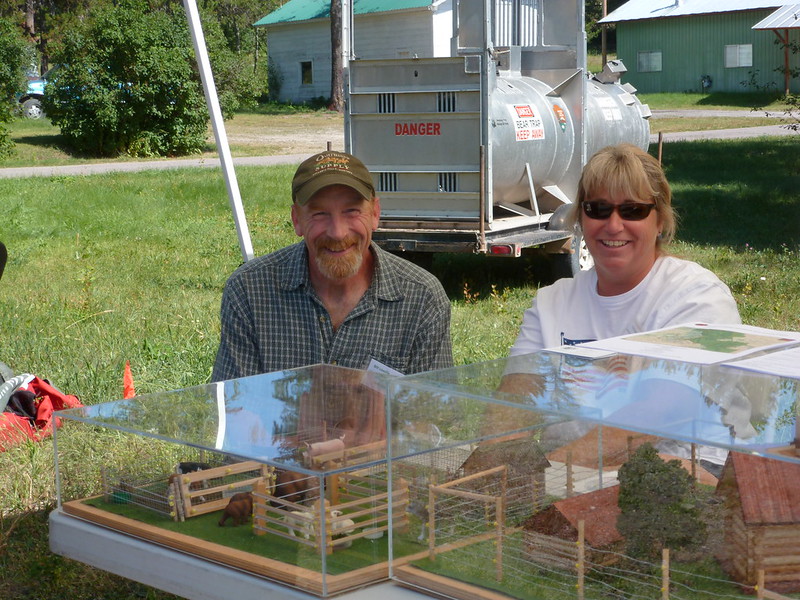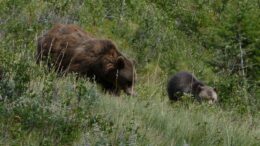Bruce McLellan recalls seeing his first grizzly bear when he was only 4 years old. It must have made an impression. He became a wildlife ecologist and devoted his career to studying the hulking bruins — much of it in the same remote place.
He moved to the wilds of the Flathead Valley in Canada in 1978 with his wife, Celine, and spent more than 40 years there, capturing, radio-collaring and then following the lives of 170 different grizzlies. He and Celine, who often accompanied him during his work, built a cabin along the Flathead River, where they raised two children.
During that time they contended with wildfires, floods, wildlife and even creepy neighbors. But living there also allowed McLellan to live amongst the animals he was studying. He followed the whole lives of several female bears who lived into their late 20s and early 30s.
“It’s interesting, but it also gets emotional,” he told The Revelator.
McLellan chronicles his personal and professional adventures in a recent book, Grizzly Bear Science and the Art of a Wilderness Life: Forty Years of Research in the Flathead Valley. The book combines anecdotes of his field work and personal life — collaring grizzlies is no easy task, and neither is raising children in the wilderness. The book also delves into his scientific findings about bear behavior and ecology.
The Revelator spoke with McLellan about how research methods evolved over his career, what climate change will mean for grizzlies, and how people can be better neighbors to bears.
You’ve spent decades studying grizzlies. Why write this book now?
There are a few reasons. One is that I’ve written several dozen scientific journal papers, and I don’t think anyone, besides other scientists, really reads them. And when I’m out in the forest, which I am a lot, I bump into various hunters and campers and other people, and they’re very unaware of what we [scientists] are doing. Yet they’re very curious. Given that ultimately these taxpayers have paid for my work, I thought it was my duty to let them know what I’ve done in the last 45 years.
I also think that there’s a disconnect happening between scientists and the general public in our greater society. And I hope [the book] lets people know what scientists do and to realize that scientists are just normal people. We’re not trying to make stuff up. We’re not lying. No one’s telling us what to say. We’re just trying to learn and provide information so that decision makers — whoever they are — can make better decisions.
There’s also a lot of personal stories in there. I’m sure if it was just all grizzly bear science, it wouldn’t be quite as easy to read. So I broke it up with stories about our life. I think it was fairly unique what we ended up doing, building our cabin and raising our kids in the wilderness.
How have methods of studying grizzlies changed over the course of your long career?
When I started on grizzly bears in 1978, the radio collars that [researchers Frank and John] Craighead invented in the Sixties were just becoming fairly reliable. Somewhat uniquely is that we lived [where we were tracking bears]. So I’d track these bears every day with radio telemetry. I didn’t know it at the time, but most studies don’t do that. They just put on collars and then locate the bears from an aircraft every week or two. But we followed these individuals daily and watched them all the time.
Of course that also included animal capture, and the drugs we used for that have evolved a lot over the 45 years, and so too have the capture methods.
Then as far as radio tracking goes, around the late 1990s and 2000s is when GPS technology became available. Then seven or eight years later uplinks through satellites became available. All of a sudden you have very accurate locations, but you never had to actually go out and track the bears.
Right now all the data just comes to your computer. You don’t have to go outside. These days you can hire a helicopter company to put radio collars on and then take them off. You get wonderful data, but sometimes I wonder if people really know what’s going on because there’s many things happening in the wild.
Another big change in technology that we were involved in was DNA. The group I was working with designed the hair-trapping method of getting hair from an animal. From that we can identify individuals and sex. That allowed us to finally count bears properly in forested areas and look at gene flow. We also used chemical isotopes to look at trophic levels of bears’ diets.
Lots of things have changed, and I think we can learn a lot more now, but I still worry that all these technological advances more or less mean more time in front of a computer and less time in the forest with the animals. And that’s too bad, in a way. You learn a lot by just observing.
What did you learn about their behavior?
From a behavioral point of view, grizzly bears aren’t territorial. Neither sex is. They have big home ranges that overlap. The males compete for breeding opportunities with females, and the females are promiscuous. They’ll mate with several males, often to confuse paternity so that the males don’t want to kill the babies because they think they’re the dad.
The males fight and compete over the females. Most males we catch in the spring are all beat up because they’ve been scrapping.
Most females don’t disperse much. They stay near their mother’s home range, which is very beneficial because that allows areas to have a fairly high density of bears because the females aren’t big wanderers, which makes them not as vulnerable.
These are still big areas, but not compared to males’ ranges. There’s nowhere on the continent big enough for males to live without being killed. But females have smaller ranges and smaller dispersal distances. Many females die of natural causes.
How well are grizzly bears doing?
In the United States two or three centuries ago they were found over enormous areas — from New Mexico through California. And in Canada they were across the prairies and Saskatchewan into central Manitoba. The European settlers had a war on carnivores and more or less wiped out grizzly bears, wolves and cougars.
In British Columbia we didn’t lose them nearly to the level that you did in the lower 48, largely because a lot of our province is pretty mountainous and relatively inhospitable for humans.
Since the Endangered Species Act listing of grizzlies in 1975, I think the mentality has changed in the United States and Canada. Since then populations have been recovering in both countries.
In the last 50 years, Yellowstone has gone from roughly about 200 bears to 1,000. And the northern Continental Divide has gone from 400 or 500 up to over 1,000. In southern British Columbia it’s the same. The Flathead population tripled in the years I was down there.
With my first publication in the 1980s on the Flathead bears, I had them increasing quite rapidly, and I was concerned that my results were questionable because it was generally thought that bears don’t go up very fast and they’re not doing well. The belief was that they were going extinct.
In general they’re recovering after nearly being wiped out. But we still have a few very troublingly small populations, including in the southern Coast Range of British Columbia and in the North Cascades in Washington.
But as their numbers are coming up, now we’re dealing with more conflict issues [with people]. People aren’t used to it, and some people are quite nervous. They have to habituate to bears.
The biggest challenge now is coexistence. How do we live with grizzlies in our farmlands and our yards and our rural 5-acre subdivisions?
How can we be better neighbors?
The number-one thing is to get rid of your attractants. Bears are driven by food, and humans have great food, whether it’s apple trees or garbage or the list goes on. If you don’t want bears around and you want your fruit or your chickens or whatever to yourself, you have to protect it. You’ve got to have electric fences. If not, you’re giving it to the bears and you’re also having them come around your place.

I have a small vineyard and fruit trees, and I have electric fences. The bears can’t get into what I want. However, I also have a bunch of apple trees, and I have a big sockeye salmon stream right through the middle of my property.
They can have that. But they’re safe here, and they’re not safe everywhere.
The other thing is that you’re going to have to learn to have them around. As my daughter points out, putting on bear spray should be just like putting on your coat if you go for a jog or something. Where she lives in another part of British Columbia, it’s just what you do.
Her daughter, who’s 12 — when she wants to go biking, she takes bear spray, and she knows how to use it. Those are the things we’re going to have to start learning to deal with. There’s lots we can do. It’s going to take effort, education, money and skilled people.
How could climate change affect grizzlies?
It’s a bit of a wildcard. I’m not a climate biologist, but when I look at the models, I have a feeling that there’s going to be some areas, like the fruit systems, that may end up actually getting better because there’ll be more wildfires.
Most fruits do way better in the sun. Huckleberries and buffalo berries are two very major fruits that do really well after fire. Perhaps with more fires, we’ll have big berry fields. That’s certainly been the case. The big berry fields in the Flathead were all caused by big fires in the 1930s, when there were record-high temperatures.
But other areas will suffer. Salmon is an obvious one. They’re not doing well all through coastal Alaska, British Columbia, Russia and Japan for many reasons, but a warming climate is a big one — whether it’s warming in the ocean or the melting of the glaciers or the warming of the streams.
Then there’s the whitebark pine — that’s another major bear food in Yellowstone and the dry side of the Coast Range and the interior mountains of British Columbia. It’s doing quite poorly.
Another issue is climate refugees. What happens to the people in Texas or Oklahoma when it gets too hot to live there? Where are they going to go? They might start moving into Montana and into British Columbia. Humanity will be shifting northward, I assume. And that’s where the bears are. So that’s also a great concern for me.
How we live with an increasing number of bears I think will be the future challenge.
Previously in The Revelator:
![]()


